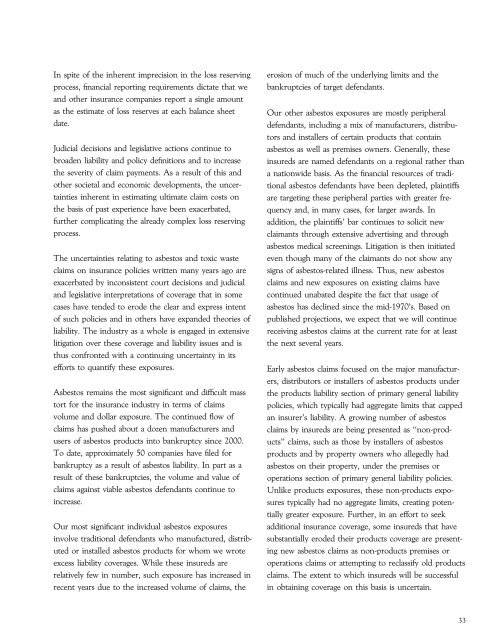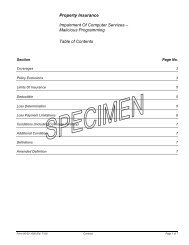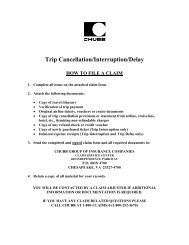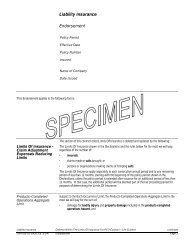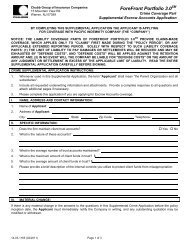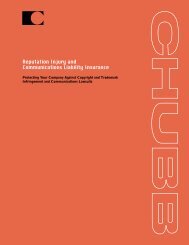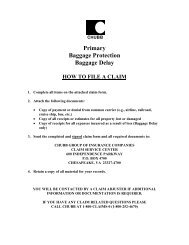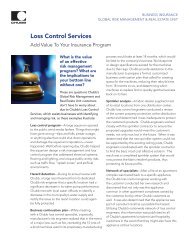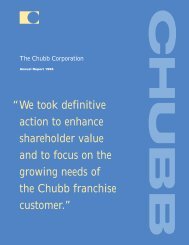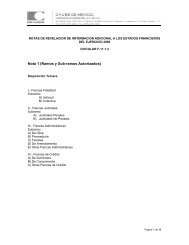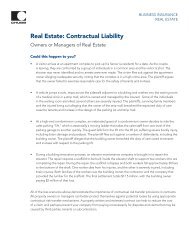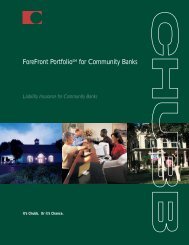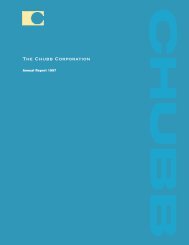Annual Report 2001 - Chubb Group of Insurance Companies
Annual Report 2001 - Chubb Group of Insurance Companies
Annual Report 2001 - Chubb Group of Insurance Companies
Create successful ePaper yourself
Turn your PDF publications into a flip-book with our unique Google optimized e-Paper software.
In spite <strong>of</strong> the inherent imprecision in the loss reserving<br />
process, Ñnancial reporting requirements dictate that we<br />
and other insurance companies report a single amount<br />
as the estimate <strong>of</strong> loss reserves at each balance sheet<br />
date.<br />
Our other asbestos exposures are mostly peripheral<br />
defendants, including a mix <strong>of</strong> manufacturers, distributors<br />
and installers <strong>of</strong> certain products that contain<br />
asbestos as well as premises owners. Generally, these<br />
insureds are named defendants on a regional rather than<br />
a nationwide basis. As the Ñnancial resources <strong>of</strong> tradi-<br />
tional asbestos defendants have been depleted, plaintiÅs<br />
are targeting these peripheral parties with greater fre-<br />
quency and, in many cases, for larger awards. In<br />
addition, the plaintiÅs' bar continues to solicit new<br />
claimants through extensive advertising and through<br />
asbestos medical screenings. Litigation is then initiated<br />
even though many <strong>of</strong> the claimants do not show any<br />
signs <strong>of</strong> asbestos-related illness. Thus, new asbestos<br />
claims and new exposures on existing claims have<br />
continued unabated despite the fact that usage <strong>of</strong><br />
asbestos has declined since the mid-1970's. Based on<br />
published projections, we expect that we will continue<br />
receiving asbestos claims at the current rate for at least<br />
the next several years.<br />
Judicial decisions and legislative actions continue to<br />
broaden liability and policy deÑnitions and to increase<br />
the severity <strong>of</strong> claim payments. As a result <strong>of</strong> this and<br />
other societal and economic developments, the uncertainties<br />
inherent in estimating ultimate claim costs on<br />
the basis <strong>of</strong> past experience have been exacerbated,<br />
further complicating the already complex loss reserving<br />
process.<br />
The uncertainties relating to asbestos and toxic waste<br />
claims on insurance policies written many years ago are<br />
exacerbated by inconsistent court decisions and judicial<br />
and legislative interpretations <strong>of</strong> coverage that in some<br />
cases have tended to erode the clear and express intent<br />
<strong>of</strong> such policies and in others have expanded theories <strong>of</strong><br />
liability. The industry as a whole is engaged in extensive<br />
litigation over these coverage and liability issues and is<br />
thus confronted with a continuing uncertainty in its<br />
eÅorts to quantify these exposures.<br />
Early asbestos claims focused on the major manufacturers,<br />
distributors or installers <strong>of</strong> asbestos products under<br />
the products liability section <strong>of</strong> primary general liability<br />
policies, which typically had aggregate limits that capped<br />
an insurer's liability. A growing number <strong>of</strong> asbestos<br />
claims by insureds are being presented as ""non-prod-<br />
ucts'' claims, such as those by installers <strong>of</strong> asbestos<br />
products and by property owners who allegedly had<br />
asbestos on their property, under the premises or<br />
operations section <strong>of</strong> primary general liability policies.<br />
Unlike products exposures, these non-products expo-<br />
sures typically had no aggregate limits, creating potentially<br />
greater exposure. Further, in an eÅort to seek<br />
additional insurance coverage, some insureds that have<br />
substantially eroded their products coverage are present-<br />
ing new asbestos claims as non-products premises or<br />
operations claims or attempting to reclassify old products<br />
claims. The extent to which insureds will be successful<br />
in obtaining coverage on this basis is uncertain.<br />
Asbestos remains the most signiÑcant and diÇcult mass<br />
tort for the insurance industry in terms <strong>of</strong> claims<br />
volume and dollar exposure. The continued Öow <strong>of</strong><br />
claims has pushed about a dozen manufacturers and<br />
users <strong>of</strong> asbestos products into bankruptcy since 2000.<br />
To date, approximately 50 companies have Ñled for<br />
bankruptcy as a result <strong>of</strong> asbestos liability. In part as a<br />
result <strong>of</strong> these bankruptcies, the volume and value <strong>of</strong><br />
claims against viable asbestos defendants continue to<br />
increase.<br />
Our most signiÑcant individual asbestos exposures<br />
involve traditional defendants who manufactured, distributed<br />
or installed asbestos products for whom we wrote<br />
excess liability coverages. While these insureds are<br />
relatively few in number, such exposure has increased in<br />
recent years due to the increased volume <strong>of</strong> claims, the<br />
erosion <strong>of</strong> much <strong>of</strong> the underlying limits and the<br />
bankruptcies <strong>of</strong> target defendants.<br />
33


